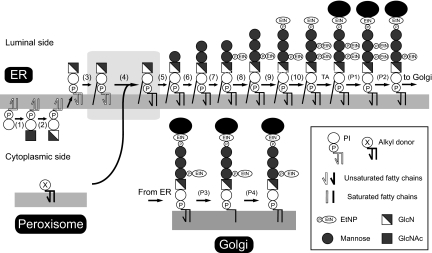Fig. 6.
The revised GPI biosynthetic pathway, highlighting cooperation of three organelles. The outlined lipid moieties represent the diacyl form and filled lipid moieties the alkyl-acyl or diacyl form. The GPI biosynthesis is initiated by transfer of N-acetylglucosamine to PI (step 1) followed by de-N-acetylation (step 2) and flipping into the ER lumen, which most likely occurs at this stage. PI and the first two GPI intermediates have an unsaturated acyl chain in the sn-2 position as represented by a kinked line. In step 3, the acyl (mainly palmitoyl or myristoyl) chain is transferred to the inositol ring to generate GlcN-acyl-PI. We propose a reaction step, an exchange of the lipid part (diacylglycerol or phosphatidic acid) (step 4). A major fraction of a putative lipid donor (lipid X) contains 1-alkyl-2-acyl glycerol generated in the peroxisome. GlcN-acyl-PI now bearing diradyl glycerol, entirely different from diacyl glycerol in cellular PI, is further processed to steps 5–10 to generate the complete GPI precursor ready for attachment to proteins by GPI transamidase (TA). The removals of inositol-linked acyl chain (step P1) and ethanolaminephosphate linked to the second mannose (step P2) occur before transportation to the Golgi. In the Golgi, fatty acid remodeling occurs in that an unsaturated sn-2 chain is removed (step P3) and stearic acid is transferred back to the sn-2 position (step P4).

